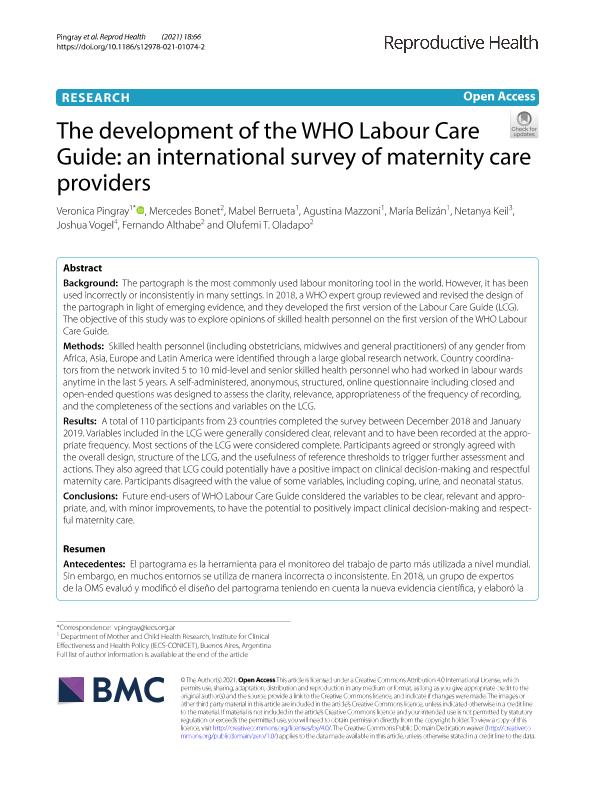Artículo
The development of the WHO Labour Care Guide: an international survey of maternity care providers
Pingray, María Verónica; Bonetto, Mercedes; Berrueta, Amanda Mabel; Mazzoni, Agustina; Belizán, María; Keil, Netanya; Vogel, Joshua; Althabe, Fernando ; Oladapo, Olufemi T.
; Oladapo, Olufemi T.
 ; Oladapo, Olufemi T.
; Oladapo, Olufemi T.
Fecha de publicación:
12/2021
Editorial:
BioMed Central
Revista:
Reproductive Health
ISSN:
1742-4755
Idioma:
Inglés
Tipo de recurso:
Artículo publicado
Clasificación temática:
Resumen
Background: The partograph is the most commonly used labour monitoring tool in the world. However, it has been used incorrectly or inconsistently in many settings. In 2018, a WHO expert group reviewed and revised the design of the partograph in light of emerging evidence, and they developed the first version of the Labour Care Guide (LCG). The objective of this study was to explore opinions of skilled health personnel on the first version of the WHO Labour Care Guide. Methods: Skilled health personnel (including obstetricians, midwives and general practitioners) of any gender from Africa, Asia, Europe and Latin America were identified through a large global research network. Country coordinators from the network invited 5 to 10 mid-level and senior skilled health personnel who had worked in labour wards anytime in the last 5 years. A self-administered, anonymous, structured, online questionnaire including closed and open-ended questions was designed to assess the clarity, relevance, appropriateness of the frequency of recording, and the completeness of the sections and variables on the LCG. Results: A total of 110 participants from 23 countries completed the survey between December 2018 and January 2019. Variables included in the LCG were generally considered clear, relevant and to have been recorded at the appropriate frequency. Most sections of the LCG were considered complete. Participants agreed or strongly agreed with the overall design, structure of the LCG, and the usefulness of reference thresholds to trigger further assessment and actions. They also agreed that LCG could potentially have a positive impact on clinical decision-making and respectful maternity care. Participants disagreed with the value of some variables, including coping, urine, and neonatal status. Conclusions: Future end-users of WHO Labour Care Guide considered the variables to be clear, relevant and appropriate, and, with minor improvements, to have the potential to positively impact clinical decision-making and respectful maternity care.
Palabras clave:
CHILDBIRTH
,
INTRAPARTUM CARE
,
LABOUR
,
PARTOGRAPH
,
WHO LABOUR CARE GUIDE
Archivos asociados
Licencia
Identificadores
Colecciones
Articulos(CIESP)
Articulos de CENTRO DE INVESTIGACIONES EN EPIDEMIOLOGIA Y SALUD PUBLICA
Articulos de CENTRO DE INVESTIGACIONES EN EPIDEMIOLOGIA Y SALUD PUBLICA
Citación
Pingray, María Verónica; Bonetto, Mercedes; Berrueta, Amanda Mabel; Mazzoni, Agustina; Belizán, María; et al.; The development of the WHO Labour Care Guide: an international survey of maternity care providers; BioMed Central; Reproductive Health; 18; 1; 12-2021; 1-9
Compartir
Altmétricas



